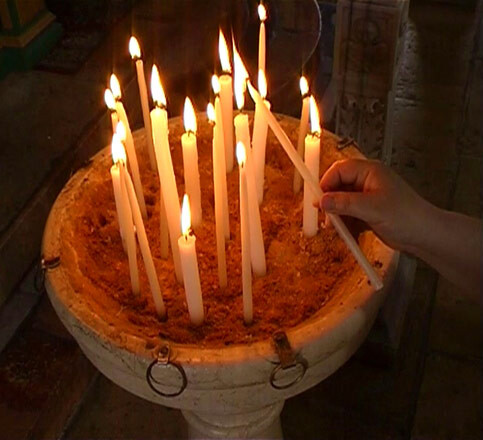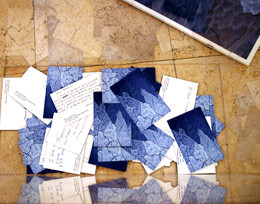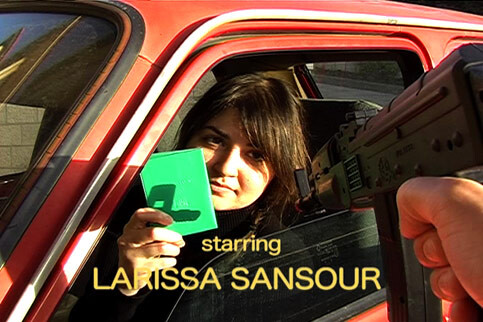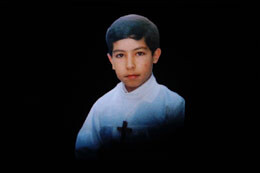The Electronic Intifada 25 April 2007

“Talk Through the Sand” by Nadira Araj
There is a significant movement brewing beneath the surface of the mainstream art world, one distinguished by interventionist action and the resolve to forge creative paths independent of the very establishments that attempt to monopolize (and corporatize) artistic agency. During the first half of the twentieth century, this translated into influential art movements and schools that sought to reshape the function of art in the face of political conflicts and instability. The Russian Constructivist, Dada and the Mexican Muralist were among a number of movements that transformed artistic conventions in reaction to contested or dramatically changing sociopolitical climates. These movements impacted the formulistic and conceptual aspects of art on such a profound scale that their influences are still shaping visual culture today.
The second half of the twentieth century was marked with a greater visibility of art movements among artists from politically marginalized and formally colonized peoples, many of which functioned outside the narrowly defined parameters of the mainstream art world. A stronger presence of female artists was also a noticeable development of this time. Making its way into the mainstream, albeit with much difficulty, this change has worked to reshape every aspect of the international art world, from the amount and type of exposure such artists are given to the formation of new art centers and markets. Yet the art world has been slow in erasing centuries of exclusion, with many artists still being shut out from the mainstream.
This is most evident in the case of Palestinian artists and art addressing the Israeli occupation of Palestine. Though Palestinian artists are recognized as some of the most experimental, prolific and influential artists of the Arab world, their opportunities to exhibit are continually restricted by the political realities that have been imposed upon their communities. The constant threat of Israeli military incursions that often involve the destroying and ransacking of art exhibitions, cultural centers, schools and the homes of artists and cultural workers is an actuality faced by both Palestinians living within the occupied territories and those living under the ever-expanding state of Israel.
Things are further complicated by the limitations that come from being required to encounter Israeli bureaucracy when traveling to or from Palestinian villages and cities. The opportunity to exhibit in other parts of the Middle East is restricted by a number of neighboring countries that refuse entry to those whose travel documents display evidence of having passed through Israeli authority. These limitations, a direct result of the Israeli occupation and the volatile history of Israeli/Arab relations, have resulted in the further punishing of a people who have been spared no cruelty. The late renowned Palestinian writer Ghassan Kanafani’s seminal short story “Men in the Sun” (1962) in which a number of Palestinian migrant workers suffocate to death while being smuggled through the desert in search of work in Kuwait, encapsulates the astonishing state of neglect turned apathy that has characterized the actions of Arab regimes towards one of the world’s largest displaced populations.

“A Secret” by Nathalie Handal
Consequently, just as artists have established artistic communities capable of fostering creativity under the formidable conditions of the Israeli occupation, artists living outside Palestine have also taken to fashioning a transnational art scene undeterred by political and geographic peripheries. In many respects this has freed creative expression from the limitations that come with having to produce work for a specific audience, market or institutionalized art world, producing some of the most revered artists, poets and writers of modern Arab culture.
As a people whose national borders have been shifting for over sixty years — with daily land grabs and the now encroaching 25 foot high Israeli “security” wall — Palestinians have remained a people without a state, being shut out of their homeland in unprecedented numbers. Yet Palestine remains cemented in the consciousness of its people. The nation is not only the physicality of land, homes, villages and cities — it is the resilience of Palestinians and the refusal to abandon their homeland. In its current form, Palestine reaches far beyond the Jordan River and the Mediterranean Sea; it lies all over the world, in places such as Amman, Beirut, Paris, London, New York, San Francisco, Santiago and Buenos Aires. Its communities, cultures, histories and landscapes are carried with its people despite their present day locations.
For many Palestinian artists, while this resolve remains an important source of inspiration, they are not solely defined by the subject of Palestine. On the contrary, artists have been part of a larger successive process in which art and culture have been actively shaping the modern day Palestinian experience. Although a great deal of the narratives explored in contemporary Palestinian art and visual culture are derived from the realities of post Nakba (Catastrophe) Palestine, each generation has redefined the boundaries of representation and creativity, radically reshaping the ways in which Palestinians view their individual and collective experiences. By doing so, these artists have subsequently affected how international audiences understand the Palestinian situation.
In the 1920s, the Mexican Muralist movement emerged during the changing sociopolitical landscape of post-revolution Mexico. Within the political zeal of the time, the school sprang from a national movement that aimed to reassert a rich cultural heritage that had experienced centuries of colonial suppression. What began in its early stages as a distinctly Mexican aesthetic soon became a movement that had a broader impact, both with its formulistic and conceptual attributes. Although to some extent the movement’s prominent artists were technically inspired by European fresco painting and international developments in Modernism, Diego Rivera, Jose Clemente Orozco and David Alfaro Siqueiros went on to revolutionize and add new approaches to modern painting. Concurrently, as their influence became rooted in the international art world, the political implications of the distinctively Mexican aesthetic began to reach far beyond its national borders, taking on universal meaning and further projecting the Mexican experience as part of a greater appeal for global political change.

“Happy Days” by Larissa Sansour
Correspondingly, as contemporary Palestinian artists continue to exhibit internationally with the same determined and prolific impetus that has characterized their work for decades, their impact on international art will further underscore the fact that the Palestinian struggle coincides with larger international political issues that the global community cannot continue to ignore.
Amidst the creative and sociopolitical contexts that configure contemporary Palestinian art, the 6+ artists collective chose to embark upon a journey that would take them not only across time zones, military check points and red tape, but through the experiences of 14 artists working to negotiate social, historical and political realities. Conceived and initiated by artists Sama Alshaibi, Wendy Babcox, Rozalinda Borcila, Mary Rachel Fanning, Yana Payusova and Sherry Wiggins, Secrets is an exhibition that disregarded conventional art world practices from its onset. The exhibition was organized without a particular curatorial premise that would serve as a basis for the selection of artists and artwork. This archetypical art world method of organizing an exhibition was not followed for a reason; Secrets was intended as a means through which six women, living throughout the United States, could open their collective to creative collaboration with Palestinian artists.
As a fundamental characteristic of 6+, the collective selects international locations in which members can work and exhibit with other female artists. The collective and its work is thus defined and impacted by the global domain. This quite involved act of working as an international art collective makes a bold creative statement within the larger context of the art world establishment. Simultaneously, each member offers unique perspectives and experiences in a multiplicity of mediums and representations. What unifies 6+ is the shared vision of wanting to create outlets through which uninhibited exchanges are realized to their utmost potential. Serving as an interventionist act, the collective has patterned a creative vehicle capable of breaking through the often unyielding definitions of contemporary art world practice.

The installation at the Khalil Sakakini Center, Ramallah
An imperative facet of the Secrets collaboration is also the touring of the exhibition in the US, since pro-Palestinian advocacy is perhaps one of the most politically repressed voices in the country. The strength of American/Israeli political and economic ties leaves the Palestinian narrative virtually omitted from the American consciousness. This is often extended to and typified by the art world. Artists who identify as Palestinian or supporting the Palestinian cause face constant censorship and exclusion in the mainstream. Made in Palestine, a group exhibition of Palestinian artists that originated at the Station Museum in Houston, Texas (2003), toured the country solely because of the efforts of grass-roots organizations that fundraised and secured independent locations in California (2005), Vermont (2005) and New York (2006). After receiving continuous rejection from museums and galleries unwilling to host the exhibition out of fear of facing controversy and the possible loss of funding, Made in Palestine went on to receive 2,000 attendees during its opening night at The Bridge gallery in Manhattan’s Chelsea district.

“Transfiguration 2006” by Faten Natsas
Conscious of the sociopolitical and cultural inferences of such desperately needed intercession, the collective has organized an exhibition whose importance lies not only in the visibility of its artists and the issues they explore but in the exchanges and connections which resulted from traveling to Palestine and working with and in the Palestinian art scene. Recently there have been several attempts by international curators and artists to reach out to their Palestinian counterparts living under the occupation, mostly by bringing the work of non-Palestinian artists to venues throughout the territories. While these efforts are commendable, there is a missing element — a creative process that engages and supports local Palestinian artists and their communities. What might be initiated as an effort to lessen the isolation many Palestinians feel while the occupation persists and much of the world looks on, can in fact create a greater sense of exclusion.
The remarkable way in which the Secrets concept differs from previous exhibitions is in its genuine desire to probe and push the boundaries of how artists impact each other, their communities, the art world and the global political sphere. The exhibition demonstrates the act of reclaiming cultural agency. By defying the limitations of imposed art world exclusionist tendencies that directly correlate with political trajectories, it exemplifies a refusal to be dictated by supposed social and cultural norms. This is most evident in the extent to which 6+ members have assured that the exhibition takes place. Concerned with the welfare of the work as it travels to and from each venue, the collective has personally transported and installed the exhibition numerous times since its inception. In several instances members shared the task of assuring that the work reached its venue by traveling to the West Bank, carrying the works through checkpoints and installing the exhibition. This sense of commitment and how it has shaped every aspect of Secrets is better understood through the response of 6+ member Sama Alshaibi when asked what the collective had envisioned of the exhibition:
To help each artist see the full realization of their work, to treat every member of the collective and collaborating artist with respect and dignity, and to understand all limitations and to work together to solve any and all problems. To learn more about each other through the art and the full experience. To grow. To always remember that the person is more important than the exhibition. To get the word out that Palestinians are a people who are occupied, but they are a free people inside their hearts. Their culture, art and humanity are larger than any silencing mechanisms put in their way. To not take no for an answer. To show the work in the US and to try our best to make sure all of them [the collaborating artists] can come here so we can be as generous to them as they were to us. To have symposiums, workshops, lectures, events etc. to maximize the potential and reach for the work to be heard … to have a powerful exhibition and meaningful experience that all of us believe in.
This essay was excerpted from the forthcoming exhibition catalog “Secrets.” All rights reserved to Maymanah Farhat and the 6+ collective, 2007.
The Secrets exhibition toured the following locations in Palestine: International Center of Bethlehem (28 September 2006); Khalil Sakakini Center,
Ramallah (2 December 2006); Al Hoash Gallery, Jerusalem (14-31 December 2006). The exhibition will open in the United States at the following venues: Dairy Center for the Arts, Boulder, Colorado (27 April-3 June 2007); Glass Curtain Gallery, Chicago, Illinois (March 2008)
Related Links





